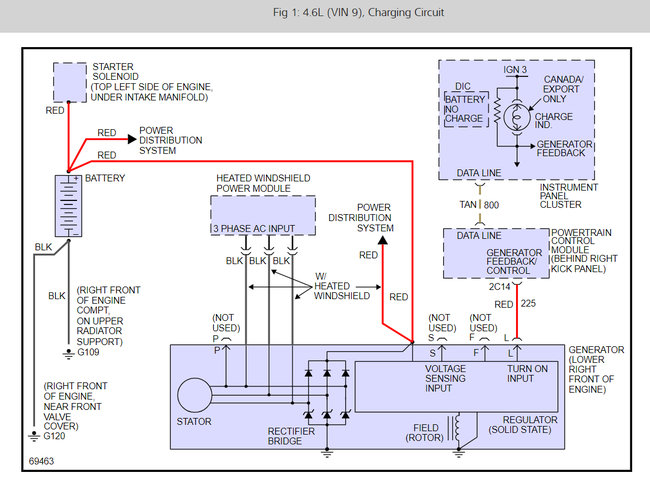The fat wire bolted on the back is the output wire. It is tied right to the battery so both places will have full voltage all the time. On most models this is also the terminal where internally the voltage regulator senses system voltage. This is the place it wants to keep charging voltage between 13.75 and 14.75 volts.
Most models of this era had a small brown wire in the plug that came from the "battery" light on the dash. When the ignition switch is turned on, current flows through the warning bulb, then to the generator on that brown wire. That is the turn-on signal for the voltage regulator to start operating. Most of the 12 volts is dropped across the bulb, so it will be on. About two remaining volts will be found on the brown wire. Once the engine is running and the generator is charging, the voltage regulator will put full charging voltage of roughly 14 volts back out on that brown wire. Now, with the same 14 volts on both sides of the warning bulb, the difference is 0 volts, so the bulb goes out.
On your car there is a red wire instead of a brown wire. The function is the same, but here the engine computer is in between the generator and the warning light. They are making the computer turn the warning light on and off. By involving the computer, it can set diagnostic fault codes related to the generator's operation.
In a few applications, mostly trucks, I think, that have digital dashes, it is extremely critical they be fed a rock solid supply voltage to prevent them from flickering. These will have a wire added to the generator's plug so it can sense system voltage remotely right at the dash instead of at the generator's output terminal. For all the rest of the electrical system, tiny voltage fluctuations are of no concern and are completely normal. They are even too insignificant to see head lights flicker at night. I am not aware of any other system that needs its voltage regulated so carefully.
The diagram Ken posted shows a heated windshield power module that I have never seen before. All AC generators, (aka "alternators"), put out three phase output, which is very efficient, but that is alternating current that cannot be stored. It has to be changed to DC current so it can be stored in the battery. Everything on cars is designed to run on DC current, but my suspicion here is that heated window module must draw a lot of current, and it does not have to be DC to work. It looks like they are tapping off the current before it goes through the rectifier diodes so those diodes do not have to be so beefy. Those six diodes are one way valves for electrical current flow, and all alternators have them. Each one has to be tough enough to pass the full rated current of that particular generator, and that is getting to be over 150 amps today, compared to 65-amp units that were considered really large in the 1980's. As current capacity goes up, cost of those diodes goes up real fast. If they do not need to rectify the current needed for the heated window module, the capacity of the generator can be smaller, and the cost will be a lot lower.
Friday, June 1st, 2018 AT 1:08 AM




